The Age of Information in Wireless Cellular Systems: Gaps, Open Problems, and Research Challenges
Abstract
:1. Introduction
1.1. Goals and Contributions
- A detailed analysis of the components contributing to the AoI and PAoI metrics in the general setting of state update applications implemented over a cellular system.
- An overview of the existing queueing-theoretic and applied studies addressing the AoI and PAoI metrics and identification of gaps between the reviewed wireless technologies and queueing-theoretic models.
- Outlining of the open problems and research challenges related to the development of the queueing-theoretic tools for performance assessment of the AoI/PAoI metrics for future mMTC and URLLC technologies.
1.2. Paper Structure and Other Reviews
2. Age of Information in Technical Systems
2.1. System Model
- i—the ED index;
- —the timestamp corresponding to the time instant of update generating on ED i side;
- —the set of readings (e.g., —temperature, —humidity, —vibration, etc.) contained in the update generated at time instant by ED i;
- —the timestamp corresponding to the time instant of the end of update processing on the CC side.
2.2. Single ED System
2.2.1. System Operation
2.2.2. AoI/PAoI Definitions
2.2.3. Detailed AoI/PAoI Dynamics
2.3. Multiple EDs
2.4. AoI/PAoI Analysis Challenges
2.5. AoI/PAoI Examples
3. The State of the Art in AoI and PAoI Models
3.1. Queueing-Theoretic Studies
3.2. Applied Studies
4. Open Challenges and Research Directions
4.1. Applications to Technology Optimization
5G and 6G Cellular IoT Technologies
4.2. 5G and 6G URLLC Services
4.3. Theoretical Challenges
Realistic Traffic Patterns and Scheduling Strategies
4.4. New Analysis Methods and Approaches
4.5. Queueing Networks
5. Conclusions
Author Contributions
Funding
Institutional Review Board Statement
Informed Consent Statement
Data Availability Statement
Conflicts of Interest
Abbreviations
| 3GPP | Third-Generation Partnership Project |
| 3GPP TS | Third-Generation Partnership Project Technical Specifications |
| 4G | Fourth-Generation |
| 5G | Fifth-Generation |
| 6G | Sixth-Generation |
| AAoI | Average Age of Information |
| AmI | Ambient Intelligence |
| AoI | Age of Information |
| BS | Base Station |
| CAC | Connection Admission Control |
| CC | Control Center |
| CDF | Cumulative Distribution Functions |
| CIoT | Cellular Internet of Things |
| CF | Control Function |
| CoUD | Cost of Update Delay |
| CSMA | Carrier Sense Multiple Access |
| D2D | Device-to-Device |
| DT | Data Transmission |
| EC-GSM | Extended Coverage–Groupe Special Mobile |
| ED | End Device |
| eMBB | enhanced Mobile Broadband |
| FCFS | First Come First Served |
| FIFO | First In–First Out |
| LIFO | Last In–First Out |
| FR | Fixed Redundancy |
| GW | Gateway |
| HARQ | Hybrid Automatic Repeat Request |
| HV | High Voltage |
| IEEE | Institute of Electrical and Electronics Engineers |
| IIoT | Industrial Internet of Things |
| IIR | Infinite Incremental Redundancy |
| IoT | Internet of Things |
| ITU-R | International Telecommunication Union Radiocommunication |
| LCFS | Last Come First Served |
| LoRaWAN | Long Range Wide Area Network |
| LTE-M/LTE-MTC | Long-Term Evolution Machine-Type Communication |
| LV | Low Voltage |
| MAC | Medium Access Control |
| MGF | Moment-Generating Function |
| mMTC | massive Machine-Type Communications |
| NB-IoT | Narrow-Band Internet of Things |
| NOMA | Non-Orthogonal Multiple Access |
| NPB | Non-Preemptive Bufferless |
| NPSBR | Non-Preemptive Single Buffer with Replacement |
| NR | New Radio |
| OFDMA | Orthogonal Frequency-Division Multiple Access |
| PAoI | Peak Age of Information |
| PB | Preemptive Bufferless |
| PCoUD | Peak Cost of Update Delay |
| Probability Distribution Function | |
| PLR | Packet Loss Ratio |
| PMF | Probability Mass Function |
| PROFINET | Process Field Network |
| QoS | Quality of Service |
| RAT | Radio Access Technology |
| RRA | Radio Resource Allocation |
| RRC | Radio Resource Control |
| SERCOS | SErial Real-time COmmunication System |
| SCADA | Supervisory Control And Data Acquisition |
| SHS | Stochastic Hybrid Systems |
| TSC | Time-Sensitive Communications |
| UAV | Unmanned Aerial Vehicle |
| UPF | User Plane Function |
| URLLC | Ultra-Reliable Low Latency Communication |
| VoIU | Value of Information of Update |
| WAN | Wide Area Network |
| Wi-Fi | Wireless Fidelity |
| WLAN | Wireless Local Area Network |
References
- ITU-R. Minimum Requirements Related to Technical Performance for IMT-2020 Radio Interface; M.2410-0; ITU-R: Geneva, Switzerland, 2017. [Google Scholar]
- Zhang, J.; Kang, K.; Yang, M.; Zhu, H.; Qian, H. AoI-minimization in UAV-assisted IoT Network with Massive Devices. In Proceedings of the 2022 IEEE Wireless Communications and Networking Conference (WCNC), Austin, TX, USA, 10–13 April 2022; pp. 1290–1295. [Google Scholar]
- Gu, J.; Song, C.; Liao, S.; Li, H.; Liu, M.; Wu, J. Generation rate control with AoI under traffic hole problem in vehicular networks. ITU J. Future Evol. Technol. 2022, 3, 46–57. [Google Scholar]
- Sultan, A. Ultra Reliable and Low Latency Communications. 3GPP. 2023. Available online: https://www.3gpp.org/technologies/urlcc-2022 (accessed on 14 August 2023).
- Andersen, F.R.; Ballal, K.D.; Petersen, M.N.; Ruepp, S. Ranging Capabilities of LoRa 2.4 GHz. In Proceedings of the 2020 IEEE 6th World Forum on Internet of Things (WF-IoT), Virtual, 2–16 June 2020; pp. 1–5. [Google Scholar]
- Simka, M.; Polak, L. On the RSSI-based indoor localization employing LoRa in the 2.4 GHz ISM band. Radioengineering 2022, 31, 135–143. [Google Scholar] [CrossRef]
- ETSI. Short Range Devices; Low Throughput Networks (LTN) Architecture; LTN Architecture; TS 103 358 V1.1.1; ETSI: Sophia Antipolis, France, 2018. [Google Scholar]
- ETSI. Low Throughput Network (LTN); Use Cases and System Characteristics; TS 103 249 V1.1.1; ETSI: Sophia Antipolis, France, 2017. [Google Scholar]
- Kovalchukov, R.; Moltchanov, D.; Pirskanen, J.; Säe, J.; Numminen, J.; Koucheryavy, Y.; Valkama, M. DECT-2020 new radio: The next step toward 5G massive machine-type communications. IEEE Commun. Mag. 2022, 60, 58–64. [Google Scholar] [CrossRef]
- Samuylov, A.; Moltchanov, D.; Pirskanen, J.; Numminen, J.; Koucheryavy, Y.; Valkama, M. Performance Assessment of DECT-2020 NR and Classic DECT Coexistence Mechanisms. In Proceedings of the 2023 IEEE 97th Vehicular Technology Conference (VTC2023-Spring), Florence, Italy, 20–23 June 2023; pp. 1–5. [Google Scholar]
- ETSI. DECT-2020 New Radio (NR); Part 1: Overview; TS 103 636-1; ETSI: Sophia Antipolis, France, 2020. [Google Scholar]
- Okano, M.T. IoT and industry 4.0: The industrial new revolution. In Proceedings of the International Conference on Management and Information Systems, Istanbul, Turkey, 3–6 September 2017; Volume 25, pp. 75–82. [Google Scholar]
- Ivanova, D.; Markova, E.; Moltchanov, D.; Pirmagomedov, R.; Koucheryavy, Y.; Samouylov, K. Performance of priority-based traffic coexistence strategies in 5G mmWave industrial deployments. IEEE Access 2022, 10, 9241–9256. [Google Scholar] [CrossRef]
- Schulz, P.; Matthe, M.; Klessig, H.; Simsek, M.; Fettweis, G.; Ansari, J.; Ashraf, S.A.; Almeroth, B.; Voigt, J.; Riedel, I.; et al. Latency critical IoT applications in 5G: Perspective on the design of radio interface and network architecture. IEEE Commun. Mag. 2017, 55, 70–78. [Google Scholar] [CrossRef]
- Winkelhaus, S.; Grosse, E.H. Logistics 4.0: A systematic review towards a new logistics system. Int. J. Prod. Res. 2020, 58, 18–43. [Google Scholar] [CrossRef]
- Yadav, G.; Paul, K. Architecture and security of SCADA systems: A review. Int. J. Crit. Infrastruct. Prot. 2021, 34, 100433. [Google Scholar] [CrossRef]
- Kaul, S.; Gruteser, M.; Rai, V.; Kenney, J. Minimizing age of information in vehicular networks. In Proceedings of the 2011 8th Annual IEEE Communications Society Conference on Sensor, Mesh and ad hoc Communications and Networks, Salt Lake City, UT, USA, 27–30 June 2011; pp. 350–358. [Google Scholar]
- Kosta, A.; Pappas, N.; Angelakis, V. Age of information: A new concept, metric, and tool. Found. Trends Netw. 2017, 12, 162–259. [Google Scholar] [CrossRef]
- Yates, R.D.; Sun, Y.; Brown, D.R.; Kaul, S.K.; Modiano, E.; Ulukus, S. Age of information: An introduction and survey. IEEE J. Sel. Areas Commun. 2021, 39, 1183–1210. [Google Scholar] [CrossRef]
- Abbas, Q.; Hassan, S.A.; Qureshi, H.K.; Dev, K.; Jung, H. A comprehensive survey on age of information in massive IoT networks. Comput. Commun. 2023, 197, 199–213. [Google Scholar] [CrossRef]
- Stamatakis, G.; Pappas, N.; Traganitis, A. Control of status updates for energy harvesting devices that monitor processes with alarms. In Proceedings of the 2019 IEEE Globecom Workshops (GC Wkshps), Big Island, HI, USA, 9–13 December 2019; pp. 1–6. [Google Scholar]
- Stamatakis, G.; Pappas, N.; Fragkiadakis, A.; Traganitis, A. Autonomous maintenance in IoT networks via aoi-driven deep reinforcement learning. In Proceedings of the IEEE INFOCOM 2021-IEEE Conference on Computer Communications Workshops (INFOCOM WKSHPS), Vancouver, BC, Canada, 10–13 May 2021; pp. 1–7. [Google Scholar]
- Lin, W.; Tang, Y.; You, M.; Li, S. Deployment method of power terminal edge control center based on cloud-edge cooperative mode. In Proceedings of the 2020 IEEE 5th Information Technology and Mechatronics Engineering Conference (ITOEC), Chongqing, China, 12–14 June 2020; pp. 65–69. [Google Scholar]
- Zhang, Y.; Srikanteswara, S.; Feng, H.; Arrobo, G.; Spoczynski, M.; Himayat, N.; Moltchanov, D.; Glazkov, R. Dynamic Pervasive Compute Orchestration using Information Centric Network. In Proceedings of the 2023 IEEE Wireless Communications and Networking Conference (WCNC), Glasgow, UK, 26–29 March 2023; pp. 1–6. [Google Scholar]
- Pirmagomedov, R.; Srikanteswara, S.; Moltchanov, D.; Arrobo, G.; Zhang, Y.; Himayat, N.; Koucheryavy, Y. Augmented computing at the edge using named data networking. In Proceedings of the 2020 IEEE Globecom Workshops (GC Wkshps.), Taipei, Taiwan, 7–11 December 2020; pp. 1–6. [Google Scholar]
- 3GPP. System Architecture for the 5G System (5GS); 3GPP TS 23.501 V17.4.0; ETSI: Sophia Antipolis, France, 2022. [Google Scholar]
- Inoue, Y.; Masuyama, H.; Takine, T.; Tanaka, T. A general formula for the stationary distribution of the age of information and its application to single-server queues. IEEE Trans. Inf. Theory 2019, 65, 8305–8324. [Google Scholar] [CrossRef]
- Kaul, S.; Yates, R.; Gruteser, M. Real-time status: How often should one update? In Proceedings of the 2012 IEEE INFOCOM, Orlando, FL, USA, 25–30 March 2012; pp. 2731–2735. [Google Scholar]
- Ling, Z.; Hu, F.; Zhang, H.; Han, Z. Age-of-information minimization in healthcare IoT using distributionally robust optimization. IEEE Internet Things J. 2022, 9, 16154–16167. [Google Scholar] [CrossRef]
- Chukhno, O.; Chukhno, N.; Araniti, G.; Campolo, C.; Iera, A.; Molinaro, A. Placement of social digital twins at the edge for beyond 5G IoT networks. IEEE Internet Things J. 2022, 9, 23927–23940. [Google Scholar] [CrossRef]
- Groshev, M.; Guimarães, C.; De La Oliva, A.; Gazda, R. Dissecting the impact of information and communication technologies on digital twins as a service. IEEE Access 2021, 9, 102862–102876. [Google Scholar] [CrossRef]
- Costa, M.; Codreanu, M.; Ephremides, A. On the age of information in status update systems with packet management. IEEE Trans. Inf. Theory 2016, 62, 1897–1910. [Google Scholar] [CrossRef]
- Kosta, A.; Pappas, N.; Ephremides, A.; Angelakis, V. The age of information in a discrete time queue: Stationary distribution and non-linear age mean analysis. IEEE J. Sel. Areas Commun. 2021, 39, 1352–1364. [Google Scholar] [CrossRef]
- Kosta, A.; Pappas, N.; Ephremides, A.; Angelakis, V. Non-linear age of information in a discrete time queue: Stationary distribution and average performance analysis. In Proceedings of the ICC 2020—2020 IEEE International Conference on Communications (ICC), Virtual, 7–11 June 2020; pp. 1–6. [Google Scholar]
- Chiariotti, F.; Vikhrova, O.; Soret, B.; Popovski, P. Peak age of information distribution for edge computing with wireless links. IEEE Trans. Commun. 2021, 69, 3176–3191. [Google Scholar] [CrossRef]
- Hu, L.; Chen, Z.; Dong, Y.; Jia, Y.; Liang, L.; Wang, M. Status update in IoT networks: Age-of-information violation probability and optimal update rate. IEEE Internet Things J. 2021, 8, 11329–11344. [Google Scholar] [CrossRef]
- Cohen, J.W. The Single Server Queue; Elsevier: Amsterdam, The Netherlands, 2012. [Google Scholar]
- Kaul, S.K.; Yates, R.D.; Gruteser, M. Status updates through queues. In Proceedings of the 2012 46th Annual Conference on Information Sciences and Systems (CISS), Princeton, NJ, USA, 21–23 March 2012; pp. 1–6. [Google Scholar]
- Yates, R.D.; Kaul, S. Real-time status updating: Multiple sources. In Proceedings of the 2012 IEEE International Symposium on Information Theory (ISIT), Cambridge, MA, USA, 1–6 July 2012; pp. 2666–2670. [Google Scholar]
- Najm, E.; Nasser, R. Age of information: The gamma awakening. In Proceedings of the 2016 IEEE International Symposium on Information Theory (ISIT), Barcelona, Spain, 10–15 July 2016; pp. 2574–2578. [Google Scholar]
- Costa, M.; Codreanu, M.; Ephremides, A. Age of information with packet management. In Proceedings of the 2014 IEEE International Symposium on Information Theory (ISIT), Honolulu, HI, USA, 29 June–4 July 2014; pp. 1583–1587. [Google Scholar]
- Najm, E.; Yates, R.; Soljanin, E. Status updates through M/G/1/1 queues with HARQ. In Proceedings of the 2017 IEEE International Symposium on Information Theory (ISIT), Aachen, Germany, 25–30 June 2017; pp. 131–135. [Google Scholar]
- Najm, E.; Telatar, E. Status updates in a multi-stream M/G/1/1 preemptive queue. In Proceedings of the IEEE Infocom 2018-IEEE Conference On Computer Communications Workshops (Infocom Wkshps), Honolulu, HI, USA, 15–19 April 2018; pp. 124–129. [Google Scholar]
- Huang, L.; Modiano, E. Optimizing age-of-information in a multi-class queueing system. In Proceedings of the 2015 IEEE International Symposium on Information Theory (ISIT), Hong Kong, China, 14–19 June 2015; pp. 1681–1685. [Google Scholar]
- Devassy, R.; Durisi, G.; Ferrante, G.C.; Simeone, O.; Uysal, E. Reliable transmission of short packets through queues and noisy channels under latency and peak-age violation guarantees. IEEE J. Sel. Areas Commun. 2019, 37, 721–734. [Google Scholar] [CrossRef]
- Hu, C.; Dong, Y. Age of information of two-way data exchanging systems with power-splitting. J. Commun. Netw. 2019, 21, 295–306. [Google Scholar] [CrossRef]
- Chen, Y.; Tang, H.; Wang, J. Optimizing Age of Information in Multicast Unilateral Networks. In Proceedings of the 2020 IEEE International Symposium on Broadband Multimedia Systems and Broadcasting (BMSB), Paris, France, 27–29 October 2020; pp. 1–4. [Google Scholar]
- Talak, R.; Karaman, S.; Modiano, E. Improving age of information in wireless networks with perfect channel state information. IEEE/ACM Trans. Netw. 2020, 28, 1765–1778. [Google Scholar] [CrossRef]
- Moltafet, M.; Leinonen, M.; Codreanu, M. Moment generating function of age of information in multisource M/G/1/1 queueing systems. IEEE Trans. Commun. 2022, 70, 6503–6516. [Google Scholar] [CrossRef]
- Bedewy, A.M.; Sun, Y.; Shroff, N.B. Age-optimal information updates in multihop networks. In Proceedings of the 2017 IEEE International Symposium on Information Theory (ISIT), Aachen, Germany, 25–30 June 2017; pp. 576–580. [Google Scholar]
- Kadota, I.; Uysal-Biyikoglu, E.; Singh, R.; Modiano, E. Minimizing the age of information in broadcast wireless networks. In Proceedings of the 2016 54th Annual Allerton Conference on Communication, Control, and Computing (Allerton), Monticello, IL, USA, 27–30 September 2016; pp. 844–851. [Google Scholar]
- Tripathi, V.; Talak, R.; Modiano, E. Age of information for discrete time queues. arXiv 2019, arXiv:1901.10463. [Google Scholar]
- Bojan, T.M.; Kumar, U.R.; Bojan, V.M. An internet of things based intelligent transportation system. In Proceedings of the 2014 IEEE International Conference on Vehicular Electronics and Safety, Hyderabad, India, 16–17 December 2014; pp. 174–179. [Google Scholar]
- Basnayaka, C.M.W.; Jayakody, D.N.K.; Perera, T.D.P.; Ribeiro, M.V. Age of information in an URLLC-enabled decode-and-forward wireless communication system. In Proceedings of the 2021 IEEE 93rd Vehicular Technology Conference (VTC2021-Spring), Virtual, 25 April–19 May 2021; pp. 1–6. [Google Scholar]
- Doǧan, O.; Akar, N. The multi-source probabilistically preemptive M/PH/1/1 queue with packet errors. IEEE Trans. Commun. 2021, 69, 7297–7308. [Google Scholar] [CrossRef]
- Moltafet, M.; Leinonen, M.; Codreanu, M. On the age of information in multi-source queueing models. IEEE Trans. Commun. 2020, 68, 5003–5017. [Google Scholar] [CrossRef]
- Akar, N.; Doğan, O.; Atay, E.U. Finding the exact distribution of (peak) age of information for queues of PH/PH/1/1 and M/PH/1/2 type. IEEE Trans. Commun. 2020, 68, 5661–5672. [Google Scholar] [CrossRef]
- Moltafet, M.; Leinonen, M.; Codreanu, M. Average AoI in multi-source systems with source-aware packet management. IEEE Trans. Commun. 2020, 69, 1121–1133. [Google Scholar] [CrossRef]
- Akar, N.; Dogan, O. Discrete-time queueing model of age of information with multiple information sources. IEEE Internet Things J. 2021, 8, 14531–14542. [Google Scholar] [CrossRef]
- Zhbankova, E.; Markova, E.; Gaidamaka, Y. Analysis of the AoI indicator in the industrial deployment of the IoT. In Proceedings of the Information and Telecommunication Technologies and Mathematical Modeling of High-Tech Systems 2023 (ITTMM 2023), RUDN, Tomsk, Russia, 4–9 December 2023; pp. 68–73. [Google Scholar]
- Zhbankova, E.; Manaeva, V.; Markova, E.; Gaidamaka, Y. The Peak Age of Information of URLLC service in 5G NR Systems. In Proceedings of the 26th International Conference on Distributed Computer and Communication Networks: Control, Computation, Communications, Moscow, Russia, 25–29 September 2023. Accepted Paper. [Google Scholar]
- Stusek, M.; Stepanov, N.; Moltchanov, D.; Masek, P.; Mozny, R.; Turlikov, A.; Hosek, J. Optimizing NB-IoT Communication Patterns for Permanently Connected mMTC Devices. In Proceedings of the 2022 IEEE Wireless Communications and Networking Conference (WCNC), Austin, TX, USA, 10–13 April 2022; pp. 1413–1418. [Google Scholar]
- Stepanov, N.; Moltchanov, D.; Turlikov, A. Modeling the NB-IoT transmission process with intermittent network availability. In Internet of Things, Smart Spaces, and Next Generation Networks and Systems, Proceedings of the 20th International Conference, NEW2AN 2020, and 13th Conference, ruSMART 2020, St. Petersburg, Russia, 26–28 August 2020; Springer: Berlin/Heidelberg, Germany, 2020; pp. 241–254. [Google Scholar]
- Muteba, K.; Djouani, K.; Olwal, T. 5G NB-IoT: Design, Considerations, Solutions and Challenges. Procedia Comput. Sci. 2022, 198, 86–93. [Google Scholar] [CrossRef]
- Polyanskiy, Y. A perspective on massive random-access. In Proceedings of the 2017 IEEE International Symposium on Information Theory (ISIT), Aachen, Germany, 25–30 June 2017; pp. 2523–2527. [Google Scholar]
- Gangakhedkar, S.; Cao, H.; Ali, A.R.; Ganesan, K.; Gharba, M.; Eichinger, J. Use cases, requirements and challenges of 5G communication for industrial automation. In Proceedings of the 2018 IEEE International Conference on Communications Workshops (ICC Workshops), Kansas City, MO, USA, 20–24 May 2018; pp. 1–6. [Google Scholar]
- Navarro-Ortiz, J.; Romero-Diaz, P.; Sendra, S.; Ameigeiras, P.; Ramos-Munoz, J.J.; Lopez-Soler, J.M. A survey on 5G usage scenarios and traffic models. IEEE Commun. Surv. Tutorials 2020, 22, 905–929. [Google Scholar] [CrossRef]
- Sachs, J.; Wallstedt, K.; Alriksson, F.; Eneroth, G. Boosting smart manufacturing with 5G wireless connectivity. Ericsson Tech. Rev. 2019, 2, 1–12. [Google Scholar]
- 3GPP. Service Requirements for V2X Services (Release 14); 3GPP TS 22.185 V14.3.0; ETSI: Sophia Antipolis, France, 2017. [Google Scholar]
- GSM Association. Network Slicing Use Case Requirements; Technical Report; GSM Association: London, UK, 2018. [Google Scholar]
- Pióro, M.; Medhi, D. Routing, Flow, and Capacity Design in Communication and Computer Networks; Elsevier: Amsterdam, The Netherlands, 2004. [Google Scholar]
- Gerasimenko, M.; Moltchanov, D.; Florea, R.; Andreev, S.; Koucheryavy, Y.; Himayat, N.; Yeh, S.P.; Talwar, S. Cooperative radio resource management in heterogeneous cloud radio access networks. IEEE Access 2015, 3, 397–406. [Google Scholar] [CrossRef]
- Jain, G.; Sigman, K. A Pollaczek–Khintchine formula for M/G/1 queues with disasters. J. Appl. Probab. 1996, 33, 1191–1200. [Google Scholar] [CrossRef]
- O’Cinneide, C.A. Characterization of phase-type distributions. Stoch. Model. 1990, 6, 1–57. [Google Scholar] [CrossRef]
- Fischer, W.; Meier-Hellstern, K. The Markov-modulated Poisson process (MMPP) cookbook. Perform. Eval. 1993, 18, 149–171. [Google Scholar] [CrossRef]
- Moltchanov, D.; Koucheryavy, Y.; Harju, J. The model of single smoothed MPEG traffic source based on the D-BMAP arrival process with limited state space. In Proceedings of the ICACT, Phoenix Park, Republic of Korea, 20–22 January 2003; pp. 55–60. [Google Scholar]
- Neuts, M.F. Matrix-Geometric Solutions in Stochastic Models: An Algorithmic Approach; Courier Corporation: Chelmsford, MA, USA, 1994. [Google Scholar]
- Whitt, W. A diffusion approximation for the G/GI/n/m queue. Oper. Res. 2004, 52, 922–941. [Google Scholar] [CrossRef]
- Kam, C.; Molnar, J.P.; Kompella, S. Age of information for queues in tandem. In Proceedings of the MILCOM 2018—2018 IEEE Military Communications Conference (MILCOM), Los Angeles, CA, USA, 29–31 October 2018; pp. 1–6. [Google Scholar]
- Vikhrova, O.; Chiariotti, F.; Soret, B.; Araniti, G.; Molinaro, A.; Popovski, P. Age of information in multi-hop networks with priorities. In Proceedings of the GLOBECOM 2020—2020 IEEE Global Communications Conference, Taipei, Taiwan, 7–11 December 2020; pp. 1–6. [Google Scholar]
- Chen, H.; Yao, D.D. Fundamentals of Queueing Networks: Performance, Asymptotics, and Optimization; Springer: New York, NY, USA, 2001; Volume 4. [Google Scholar]
- Kuehn, P. Approximate analysis of general queuing networks by decomposition. IEEE Trans. Commun. 1979, 27, 113–126. [Google Scholar] [CrossRef]
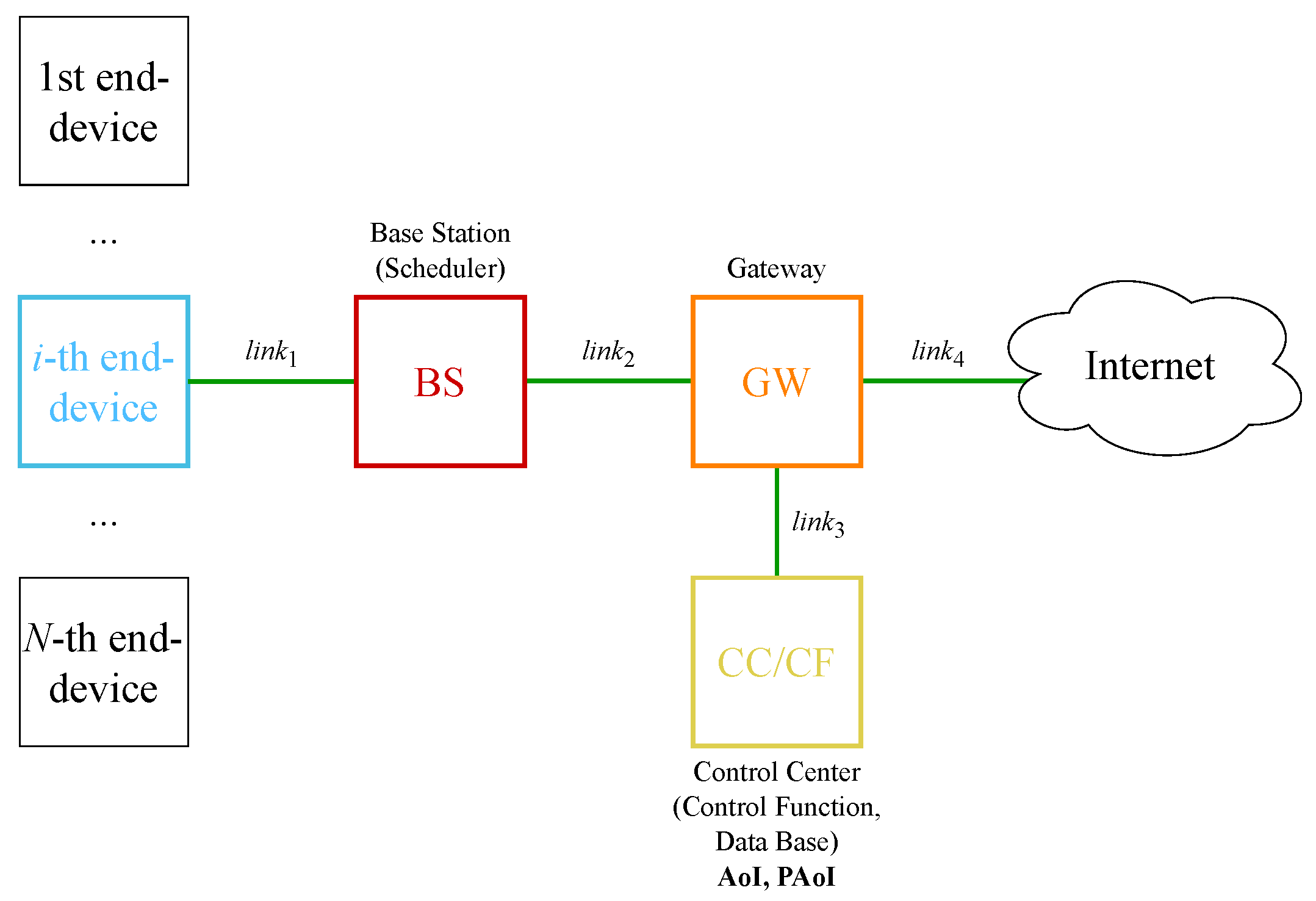
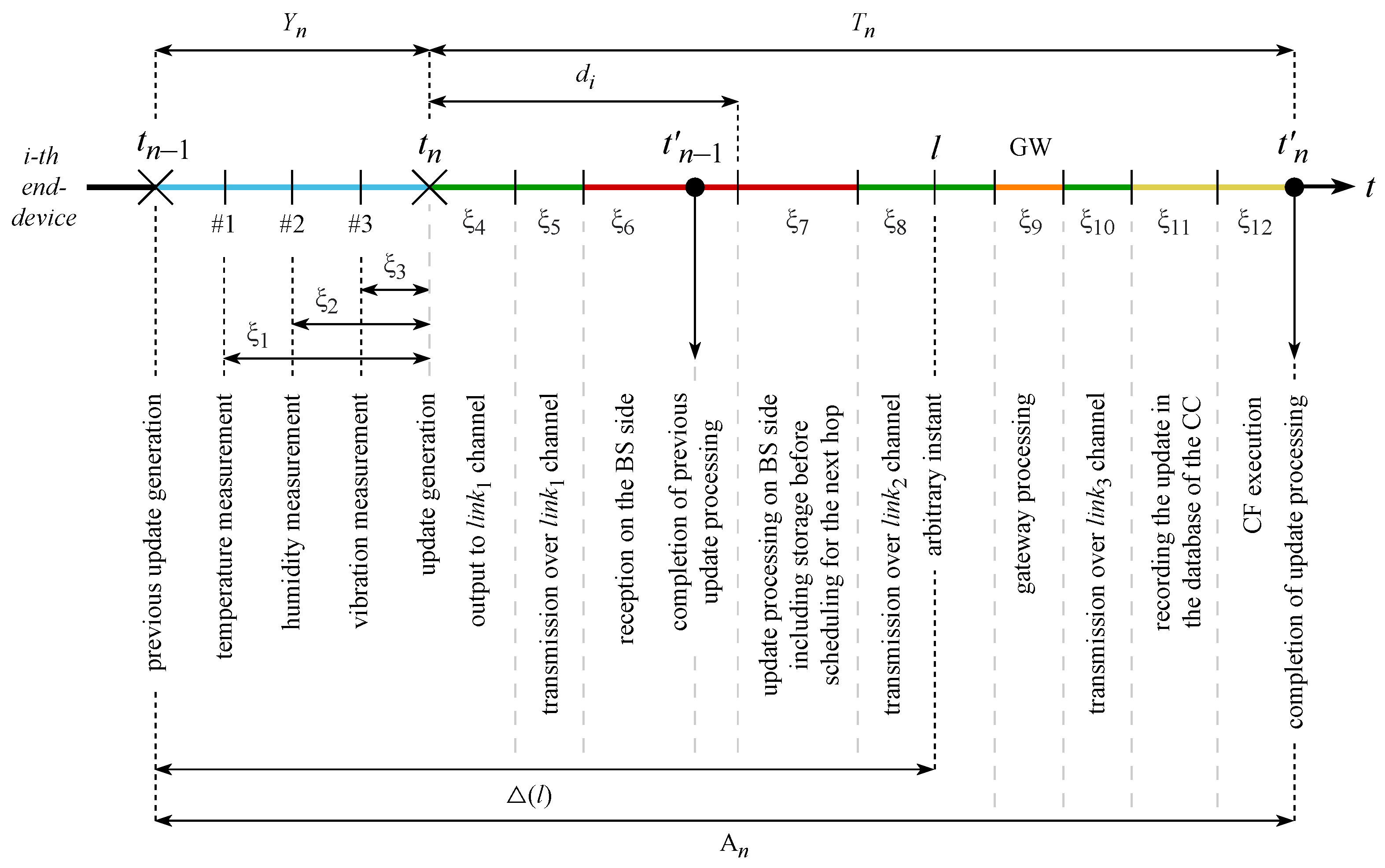
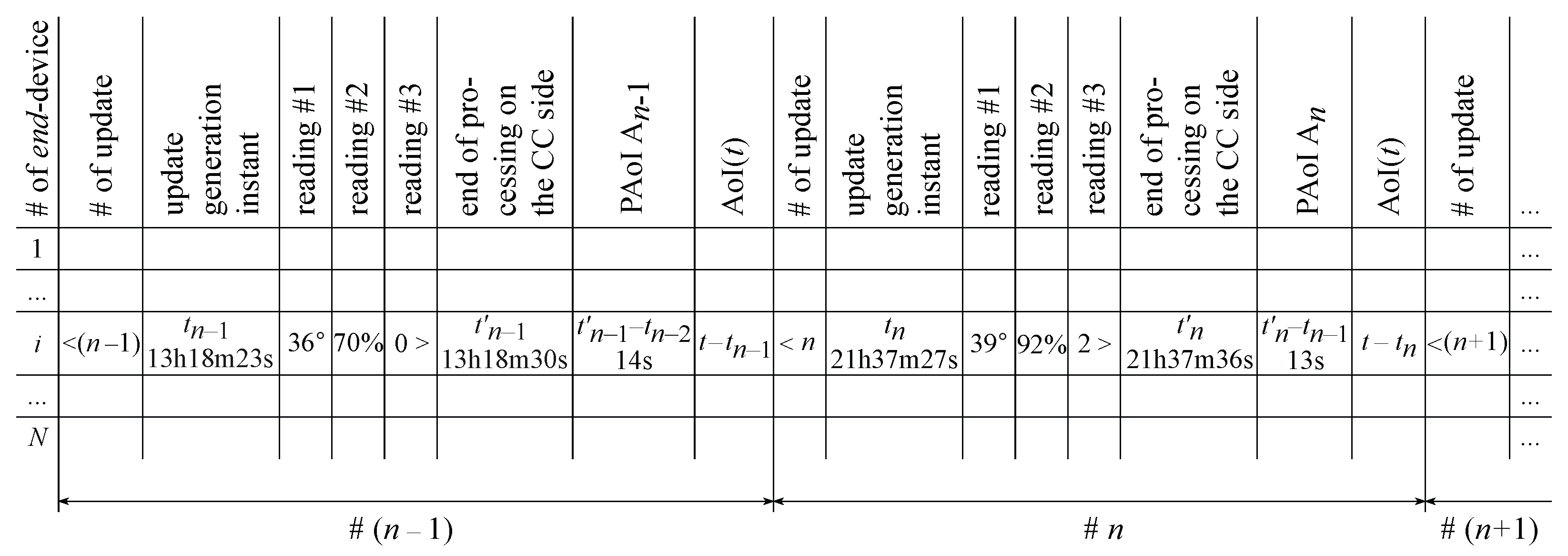


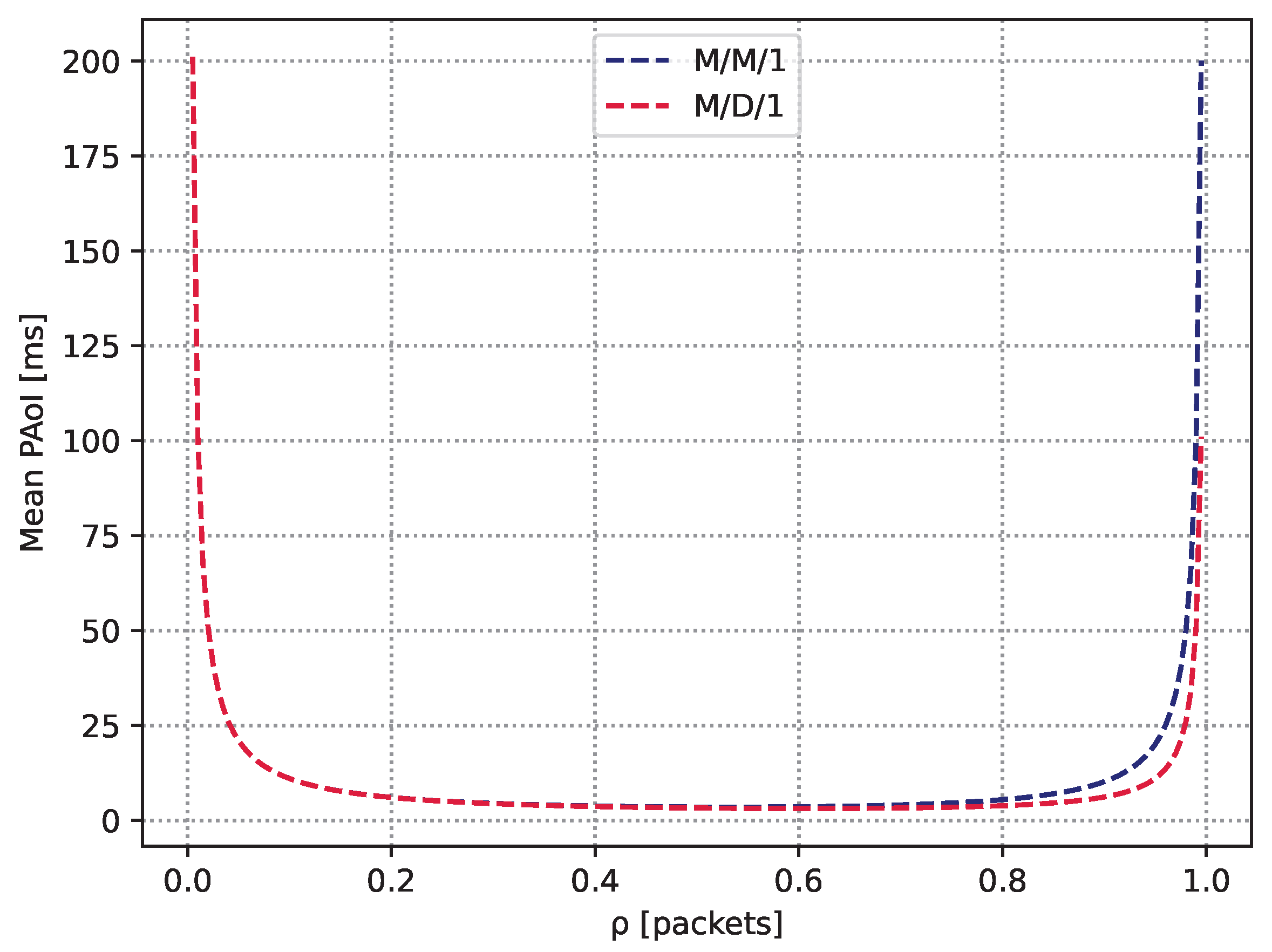

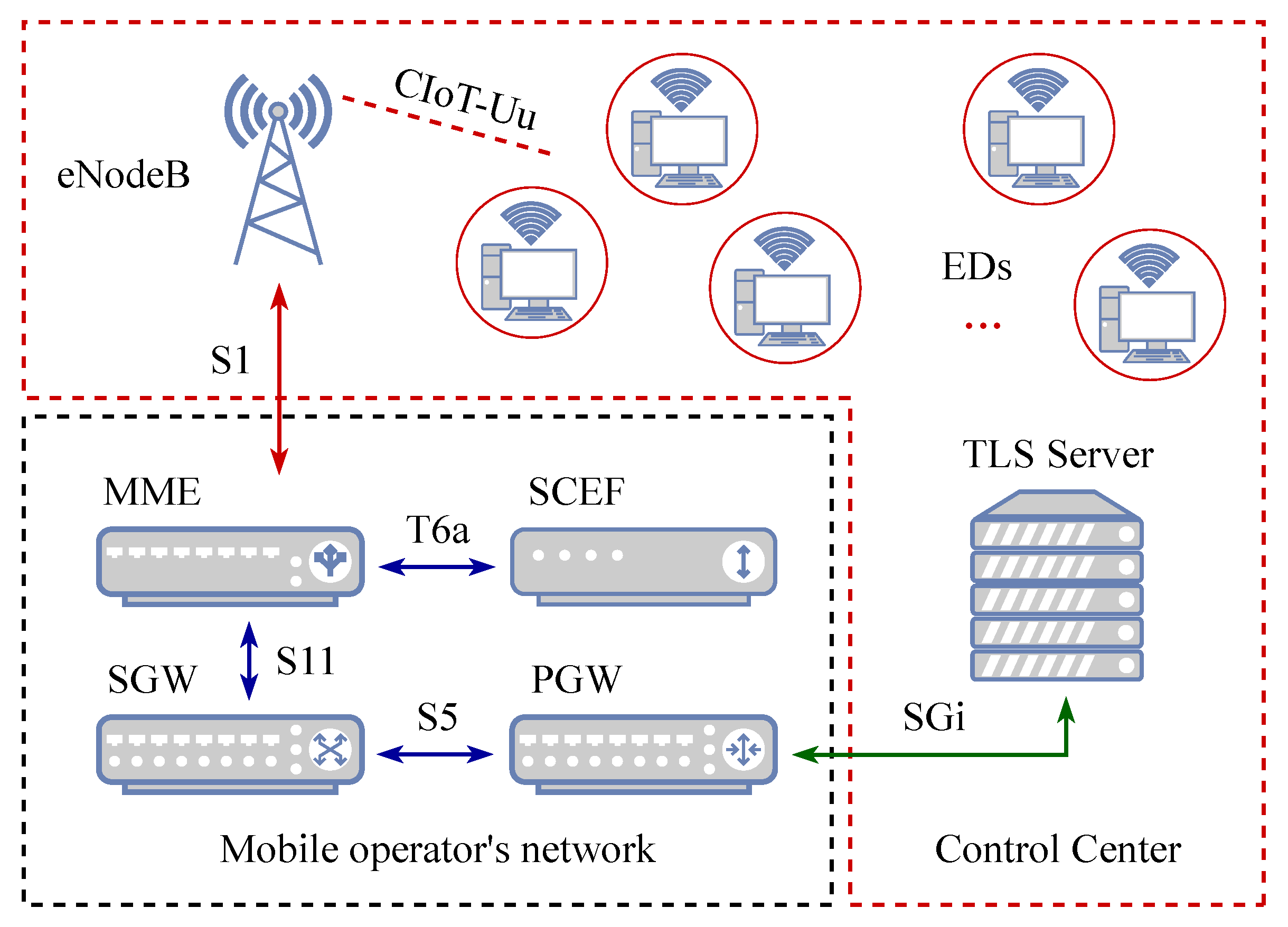

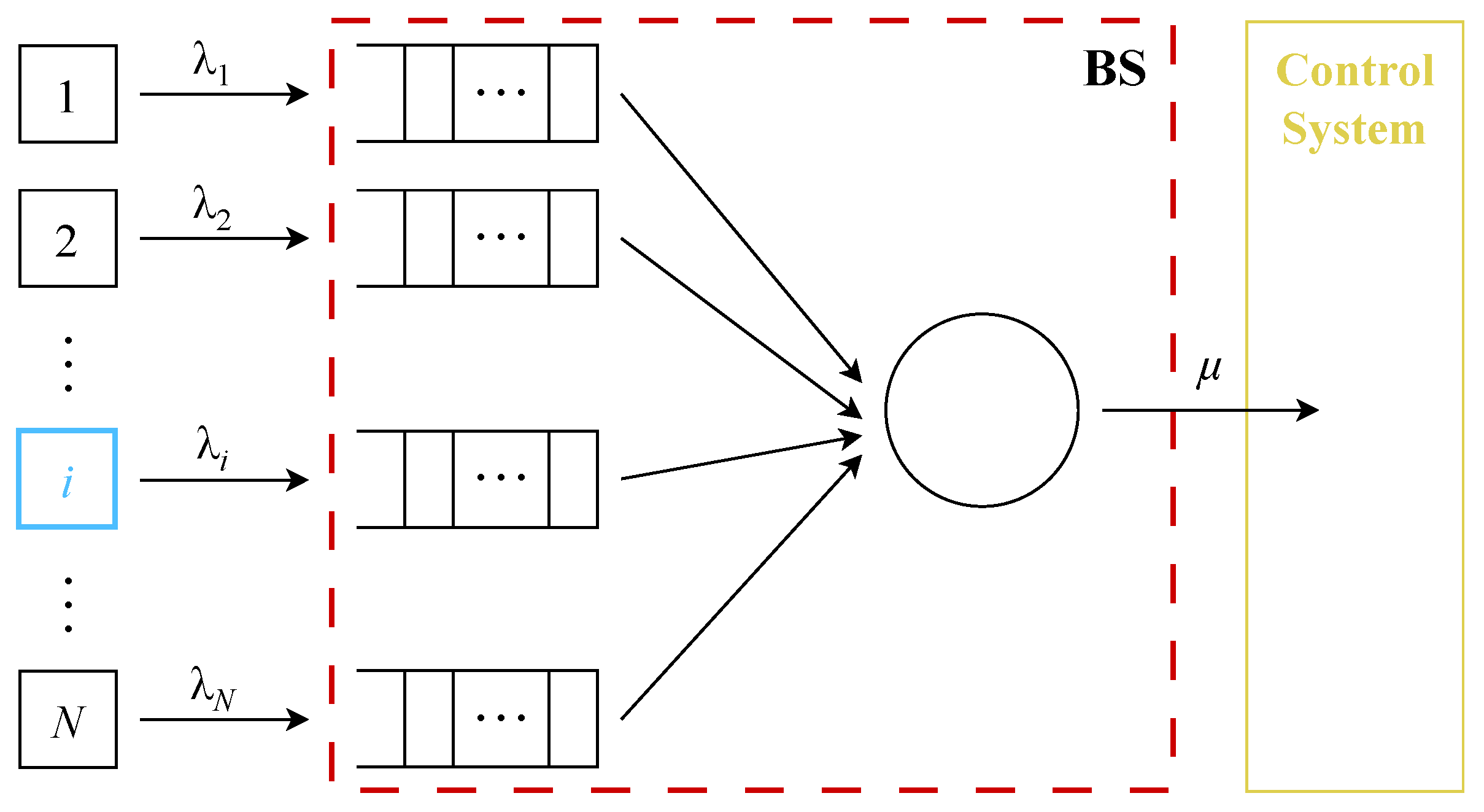
| Notation | Meaning |
|---|---|
| n | update sequence number, |
| instant of generation of the n-th update on the ED side | |
| instant of end of handling the n-th update on the CC side | |
| arbitrary instants of access to the CC database | |
| time intervals from the reading’s measurements to the start of the first bit of the corresponding update packet (the n-th update) transmission | |
| serialization time at the ED | |
| propagation delay over the wireless channel | |
| reception time of the n-th update at the BS | |
| storage duration at the BS | |
| transmission time over the high-speed | |
| handling time at the GW | |
| transmission time over the high-speed | |
| handling a record time at the CC | |
| CF execution time | |
| n-th update delivery time, | |
| time before the n-th update generation since the previous update generation | |
| the AoI at time instant t | |
| the PAoI after handling the n-th update on CC side | |
| the current PAoI at time instant t |
| Ref. | Queueing Model | Metr. | Analysis Type | Technical System |
|---|---|---|---|---|
| [17] | , LCFS | AoI, AAoI | analytics | CSMA, 802.11 MAC |
| [28] | , , , FCFS | AoI, AAoI | analytics | N/A |
| [38] | , LCFS, with/without preemption service | AoI, AAoI | analytics | N/A |
| [39] | , FCFS, LCFS | AoI | analytics | N/A |
| [40] | , LCFS with/without preemption | AoI, AAoI, PAoI | simulation | relay networks |
| [41] | , , | AoI, AAoI, PAoI | analytics, simulation | N/A |
| [42] | AoI, AAoI | simulation | IIR HARQ, FR HARQ | |
| [43] | with preemption | AoI, AAoI, PAoI | simulation | – |
| [32] | , , , FCFS | AoI, AAoI, PAoI | analytics, simulation | N/A |
| [44] | AoI, PAoI | simulation | heterogenous systems | |
| [45] | , | AoI, PAoI | analytics | URLLC |
| [34] | , discrete time, FCFS, LCFS | AoI, PAoI | simulation | N/A |
| [35] | , , FCFS | AoI, PAoI | simulation | edge computing |
| [46] | N/A | AoI, AAoI | simulation | wireless system |
| [47] | N/A | AoI | analytics, simulation | N/A |
| [48] | N/A | AoI, AAoI, PAoI | analytics, simulation | a single-hop wireless network |
| [49] | AoI, AAoI, PAoI | analytics | N/A | |
| [50] | queueing network, , LCFS | AoI | analytics | multi-hop networks |
| [51] | AoI | simulation | wireless broadcasting | |
| [52] | , FCFS, , LCFS, discrete time | AoI, AAoI, PAoI | analytics | N/A |
| [53] | N/A | AoI | analytics | IoT |
| [54] | N/A | AoI, AAoI | analytics, simulation | IoT, URLLC |
| [55] | with packet errors, | AoI, AAoI, PAoI | analytics, simulation | N/A |
| [56] | , a multi-source , FCFS | AoI, AAoI | simulation | N/A |
| [57] | , , LCFS | AoI, PAoI | simulation | N/A |
| [58] | N/A | AoI, AAoI | analytics | N/A |
| [59] | Discrete time queueing systems | AoI, PAoI | simulation | N/A |
| [27] | , FCFS and LCFS with preemption | AoI, PAoI | analytics | N/A |
| [60] | N/A | AoI, PAoI | analytics | N/A |
| [61] | , , FCFS | AoI, PAoI | simulation | URLLC |
Disclaimer/Publisher’s Note: The statements, opinions and data contained in all publications are solely those of the individual author(s) and contributor(s) and not of MDPI and/or the editor(s). MDPI and/or the editor(s) disclaim responsibility for any injury to people or property resulting from any ideas, methods, instructions or products referred to in the content. |
© 2023 by the authors. Licensee MDPI, Basel, Switzerland. This article is an open access article distributed under the terms and conditions of the Creative Commons Attribution (CC BY) license (https://creativecommons.org/licenses/by/4.0/).
Share and Cite
Zhbankova, E.; Khakimov, A.; Markova, E.; Gaidamaka, Y. The Age of Information in Wireless Cellular Systems: Gaps, Open Problems, and Research Challenges. Sensors 2023, 23, 8238. https://doi.org/10.3390/s23198238
Zhbankova E, Khakimov A, Markova E, Gaidamaka Y. The Age of Information in Wireless Cellular Systems: Gaps, Open Problems, and Research Challenges. Sensors. 2023; 23(19):8238. https://doi.org/10.3390/s23198238
Chicago/Turabian StyleZhbankova, Elena, Abdukodir Khakimov, Ekaterina Markova, and Yuliya Gaidamaka. 2023. "The Age of Information in Wireless Cellular Systems: Gaps, Open Problems, and Research Challenges" Sensors 23, no. 19: 8238. https://doi.org/10.3390/s23198238
APA StyleZhbankova, E., Khakimov, A., Markova, E., & Gaidamaka, Y. (2023). The Age of Information in Wireless Cellular Systems: Gaps, Open Problems, and Research Challenges. Sensors, 23(19), 8238. https://doi.org/10.3390/s23198238






